1. Basic concepts
(1) Mechanical seal is a device used to solve the sealing problem between the rotating shaft and the machine body. It consists of at least one pair of end faces perpendicular to the axis of rotation, which are kept in contact and slide relative to each other under the action of fluid pressure, the elastic force (or magnetic force) of the compensation mechanism and the auxiliary seal to form a device to prevent fluid leakage. It is commonly used in pumps, Rotary fluid machinery such as compressors and reaction stirrers are also used for sealing gear boxes, ship tail shafts, etc. Therefore, the mechanical seal is a universal shaft sealing device.
(2) There are various mechanical seal structures, and the most commonly used mechanical seal structure is end seal. See Figure 2-1. The static ring and moving ring of the end face seal form a pair of friction pairs. The function of the friction pairs is to prevent medium leakage. It requires the static ring and the moving ring to have good wear resistance. The moving ring can move flexibly in the axial direction, automatically compensate for the wear of the sealing surface, and make it fit well with the static ring; the static ring has floating properties and plays a buffering role. . For this reason, the sealing surface requires good processing quality to ensure good fitting performance of the sealing pair. The basic components that constitute a mechanical seal include a static ring, a moving ring, a gland, a push ring, a spring, a positioning ring, a shaft sleeve, a moving ring seal, a static ring seal, a shaft sleeve seal, etc.
(3) Elastic elements (springs, bellows) mainly play the role of pre-tightening, compensation and buffering. They are required to always maintain sufficient elasticity to overcome the friction of auxiliary seals and transmission parts and the inertia of moving rings, etc., to ensure that the end face seal pair is in good condition. The fit and followability of the moving ring are required, and the materials are required to be corrosion-resistant and fatigue-resistant.
(4) Auxiliary seal (O-shaped ring, V-shaped ring, U-shaped ring, wedge-shaped ring and special-shaped ring, etc.) It mainly plays the sealing role of the static ring and the moving ring, and also plays a floating and buffering role. The sealing elements of the static ring are required to ensure the sealing between the static ring and the gland. The static ring has a certain degree of floating. The sealing elements of the moving ring are required to ensure the sealing between the moving ring and the shaft or sleeve and the sealing of the moving ring. Floatability. Materials require heat resistance, etc.

The basic components of a mechanical seal include: 1 stationary ring, 2 moving ring, 3 gland, 4 push ring, 5 spring, 6 positioning ring, 7 shaft sleeve, 8 moving ring sealing ring, 9 stationary ring sealing ring, etc.
2.The leakage channel points of the mechanical seal are as follows:
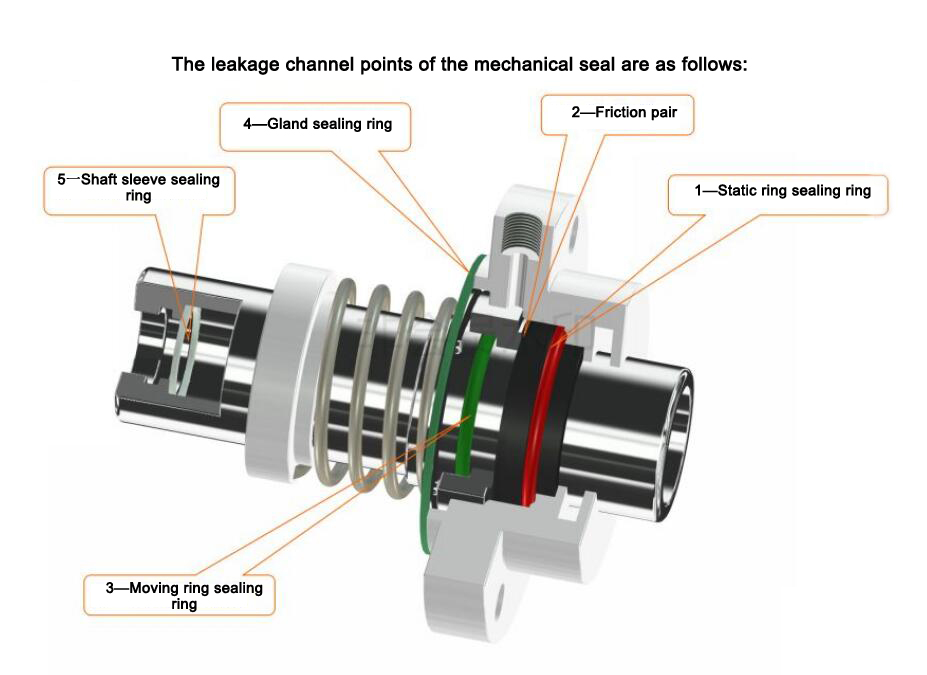
3. Advantages and Disadvantages of Mechanical Seals
1. Advantages
(1) The structure is reliable and the leakage can be limited to very little. As long as the surface roughness and flatness of the main sealing surface can meet the requirements, and as long as the material has good wear resistance, the mechanical seal can achieve very little leakage, even invisible to the naked eye. leakage.
(2) Long life. In mechanical seals, the main wear part is the end face of the seal friction pair. Because the wear amount of the seal end face is not large under normal working conditions, it can generally be used continuously for 1 to 2 years. It can also be used for 5 to 10 years in special occasions.
(3) No adjustment is required during operation. Since the mechanical seal relies on spring force and fluid pressure to make the friction pair fit and automatically maintain contact during operation, there is no need to adjust and tighten like ordinary soft packing after assembly.
(4) It has vibration resistance. The maximum amplitude does not exceed 0.05mm at a rotation speed of 3000r/min. The PV value continues to increase during use.
(5) The power loss is small. The packing seal works on the shaft or sleeve by the compression of the packing. The packing seal is in direct friction with the shaft. The tighter the packing is pressed, the greater the friction and the greater the power consumption. The friction of the mechanical seal is in a semi-liquid friction state, and the friction coefficient is very small. The power loss of the mechanical seal is 10 to 50% of that of the packing seal.
(6) The bellows seal shaft or sleeve is not subject to wear and is not sensitive to the vibration of the rotating shaft and the deflection of the shaft to the housing.
(7) Wide scope of application. When the medium is flammable, explosive, toxic and harmful, mechanical seals can be used to ensure sealing. It is also suitable for sealing equipment with high temperature, low temperature, high pressure, vacuum, various speeds and corrosive media.
2. Disadvantages
(1) If the structure is more complex than the packing seal, the processing accuracy is high, and certain installation techniques are required. In particular, the installation requirements of dry gas seals are higher. Moreover, sealing technology is developing rapidly, and new technologies are constantly emerging, which brings new issues to our maintenance.
(2) The structure is complex and it is inconvenient to disassemble and assemble. Compared with other seals, mechanical end face seals have a large number of parts, require precision, and have a complex structure. It is especially difficult to assemble. During disassembly and assembly, the sealing ring must be pulled out from the shaft end, and part of the machine (coupling) or all must be disassembled. Some improvements have been made to this problem, such as the use of split and cartridge mechanical seals that are easy to disassemble and assemble and can ensure assembly quality.
4. Typical structural forms of mechanical seals
There are many basic types of mechanical seals, and there are many classification methods. Here we only introduce some commonly used contact mechanical seal structures in petrochemical companies. Contact mechanical seal has small leakage, simple structure and wide range of use. Classification methods vary. Commonly used ones include built-in mechanical seals, external mechanical seals, etc.
1. Built-in mechanical seal, (1) Features of built-in internal flow multi-spring static contact mechanical seal: only one pair of friction pairs and multiple small springs.
The load coefficient K less than 1 can balance the effect of medium pressure on the end face. The structure is simple and easy to manufacture, disassemble and assemble. See Figure 2-3 for details
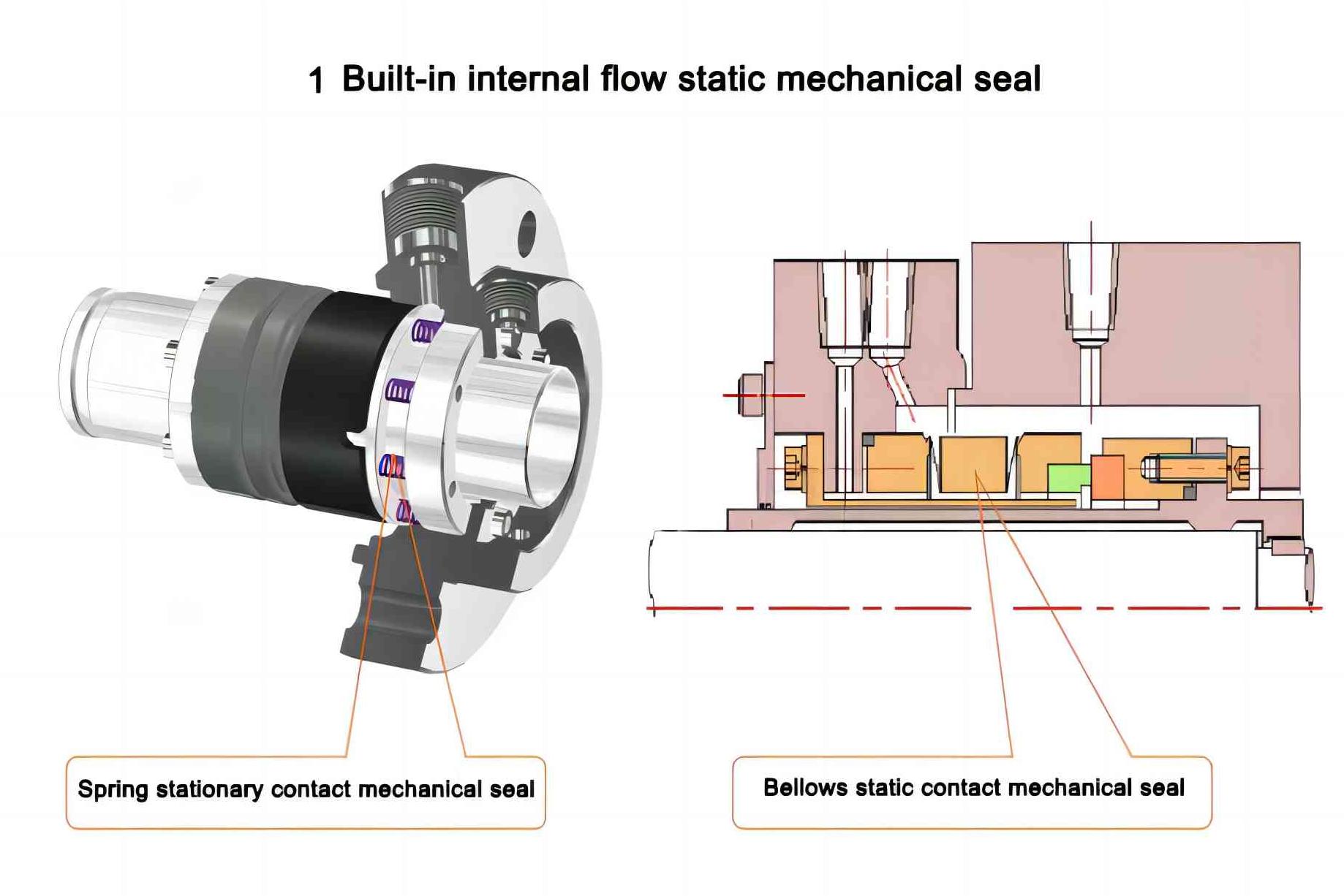

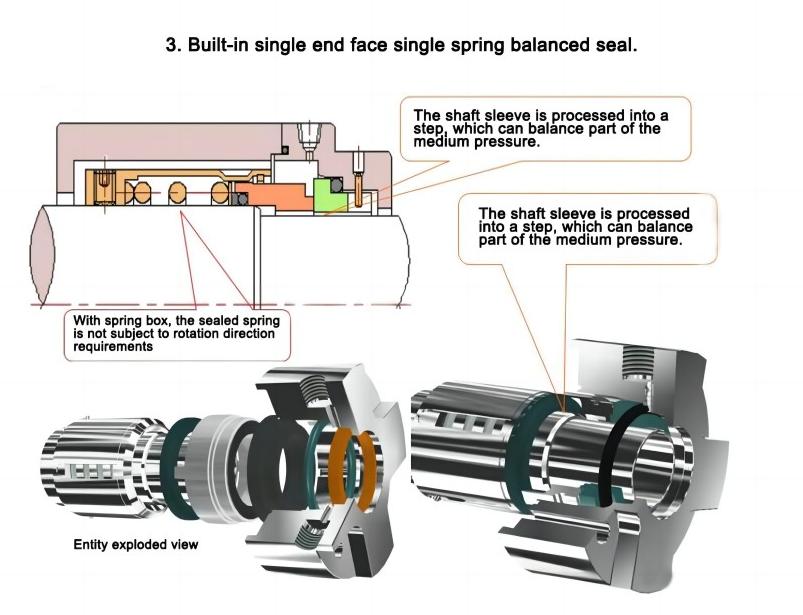

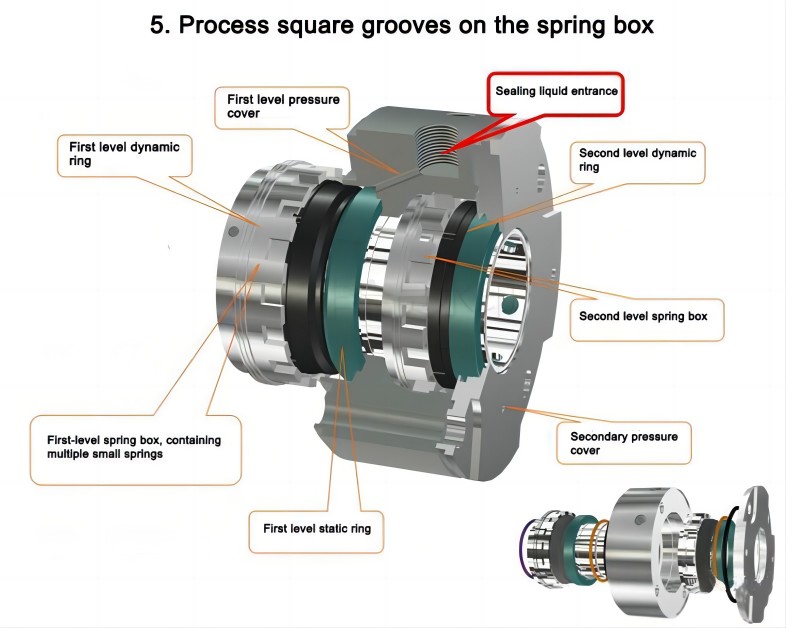
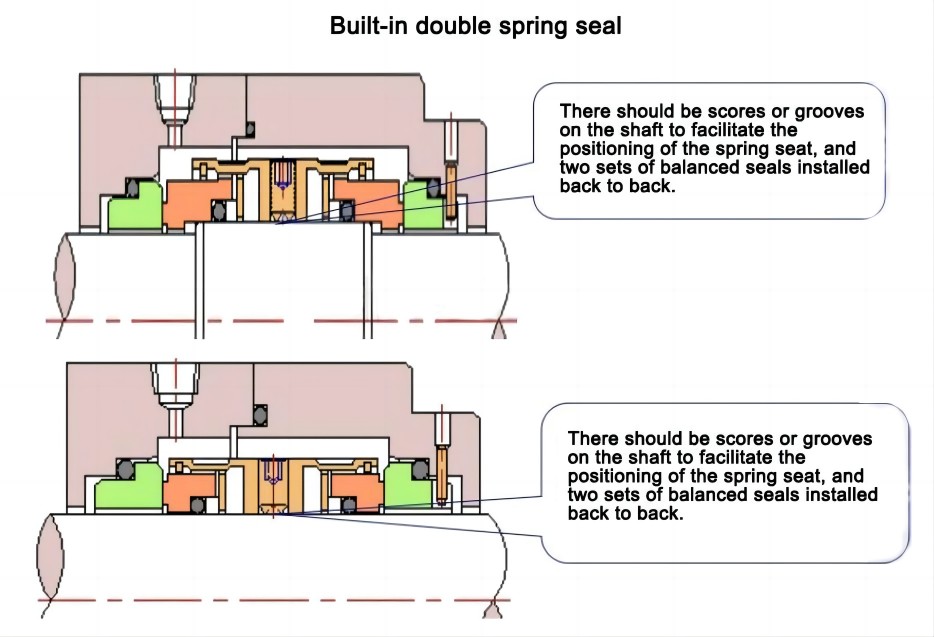 It is used in situations where the working medium is toxic, flammable, explosive, volatile, easy to crystallize, high temperature, low temperature, or gas, high vacuum, etc.
It is used in situations where the working medium is toxic, flammable, explosive, volatile, easy to crystallize, high temperature, low temperature, or gas, high vacuum, etc.
A sealing cavity is formed between the two sets of seals, and the sealing liquid is introduced into the sealing cavity: blocking, lubricating, and cooling. Select a sealing liquid medium that is clean and has good lubricity.


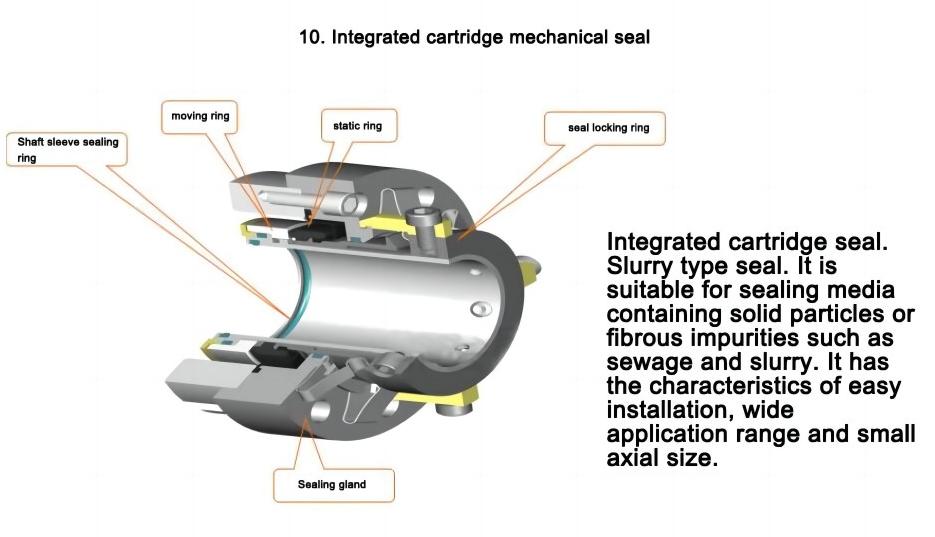

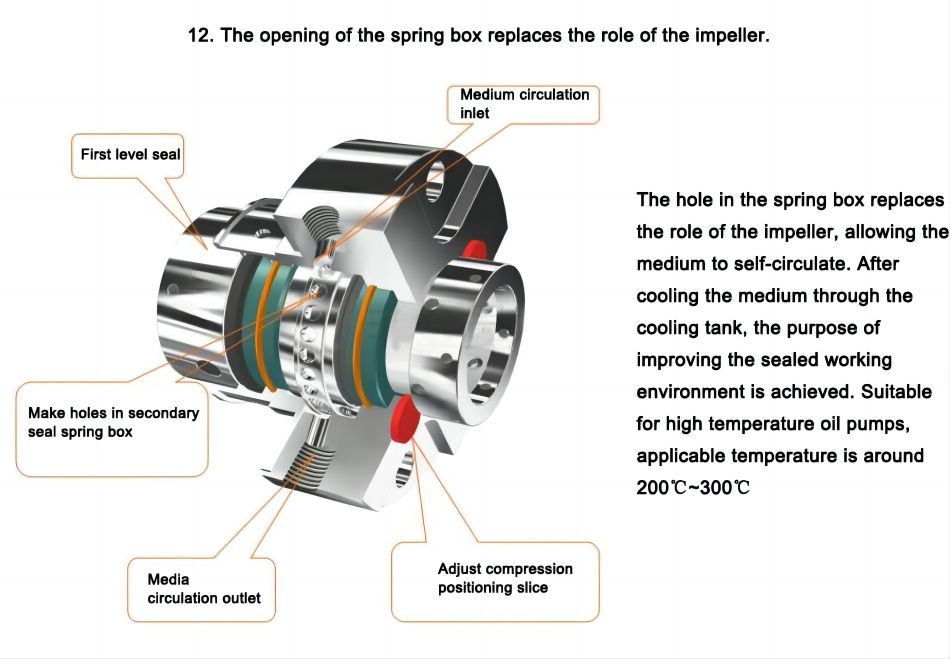
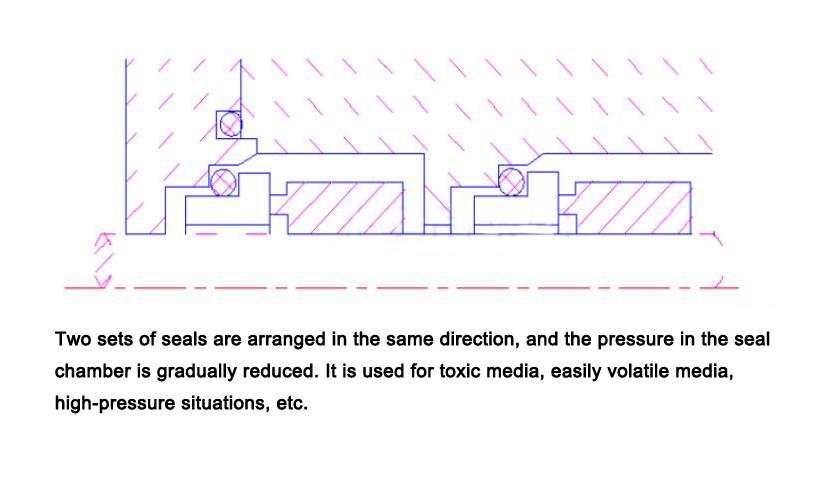


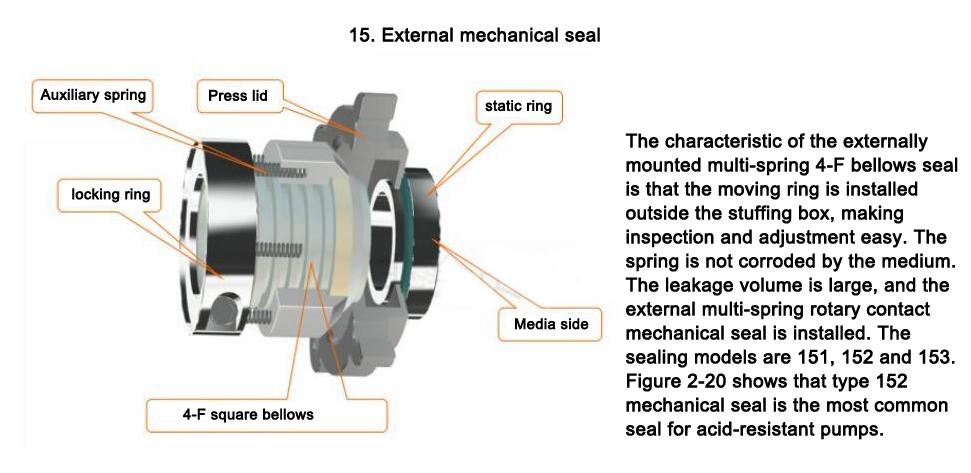
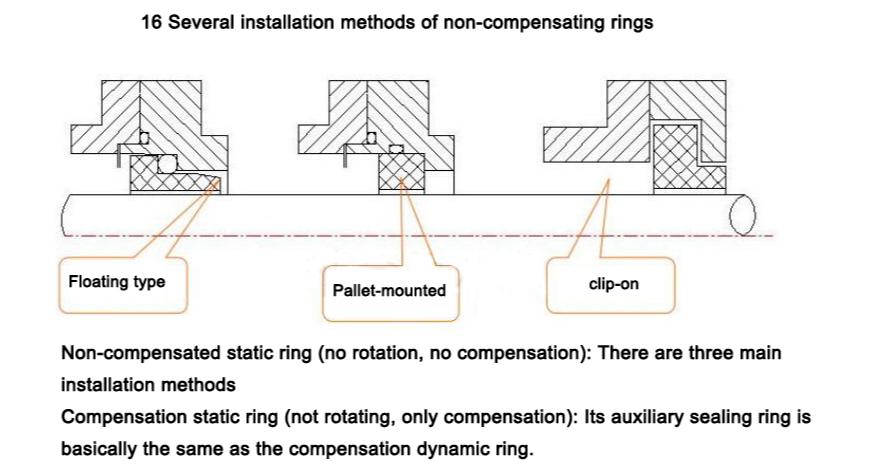

 β is the balance coefficient, which represents the degree of unloading of the specific pressure generated by mesons on the friction pair,
β is the balance coefficient, which represents the degree of unloading of the specific pressure generated by mesons on the friction pair,
Therefore, within β=1-K, 1-0.85=0.15, that is, the balance coefficient is 15%
Generally, the K load coefficient of centrifugal pumps in the petrochemical industry is K=0.63~0.85
When the seal chamber pressure exceeds 0.7MPa, the partially balanced type should be consideredFor general media, when P = 0.6~0.7Mpa or above, balanced seals are used. For media with larger viscosity and good lubrication performance, the operating pressure of unbalanced mechanical seals can exceed this value; for media with smaller viscosity and poor lubrication performance Medium, when P medium =0.29~0.49Mpa, a balanced mechanical seal must be used. The larger the balance coefficient B, the smaller the end face specific pressure caused by the medium. Although the wear is small, it is not easy to ensure sealing. On the contrary, the smaller the balance coefficient β is, the greater the end face specific pressure will be, which will intensify the wear of the end face, generate heat and even cause the risk of bite, and finally cause the seal to fail. Therefore, it is necessary to select an appropriate β value. The value is related to many factors and the situation is relatively complicated. Normally, the β value should not exceed 0.5. Otherwise, the back pressure between the end faces will cause the end faces to be pushed away.
The selection of the balance coefficient β value is related to the viscosity of the sealing medium, temperature, rotation speed, etc.
The common range of β value is 15% to 40%
That is, the load coefficient K=0.85~0.60. When other conditions remain unchanged, the larger the viscosity, the smaller the applicable β value, and the smaller the viscosity, the larger the β value used. Tests have proven that the β value of water, gasoline, kerosene and other media is about 20% to 30% (for water β = 48, it is close to the limit of end face opening. For oil with high viscosity, the β value is about 30% to 40% of the mechanical seal. β value is divided into 20%~30%
The greater the medium pressure, the greater the applicable β value; the smaller the medium pressure, the smaller the applicable β value. The β value is a very important data. Sometimes the incorrect selection of the seal can cause seal leakage.End face specific pressure
——The force acting on the unit area of the sealing end face is called the sealing specific pressure. Require:
1) The end face specific pressure must be a positive value to ensure tight fit of the sealing end face;
2) Greater than the vapor pressure of the material on the sealing end face;
3) Ensure that the liquid film exists, and the end face specific pressure should not be too large to avoid evaporation of the liquid film and aggravation of wear. It cannot be too small to avoid poor sealing performance.
The pump is built-in, generally 0.3-0.5MPa;
External type, 0.15-0.4MPa;
If the viscosity is large, increase it appropriately, generally 0.5-0.7MPa;
Poor lubrication, volatile materials, small specific pressure, generally 0.25-0.45MPa;
The reactor is external, and its specific pressure is slightly larger than that of the pump.Spring specific pressure:
The force exerted by the spring on the unit area of the sealing end face.
Function: When the medium pressure is very small or fluctuates, it can still maintain a certain end face specific pressure to prevent the medium from leaking.
Selection basis: average linear velocity of end face.
High-speed mechanical seal, average linear speed>30m/s,
Take (0.5-2.0)X9.8×10⁴Pa;
Medium speed, average linear speed 10~30m/s,
Take (1.5~3)×9.8×10⁴Pa;
Vulgar, average linear speed <10m/s,
Take (1.5~6)×9.8×10⁴Pa;
For kettle use, take Q.22MPa. (Low rotation speed, gas phase, large shaft swing, unstable operating pressure, temperature, and phase state). The value is larger.
